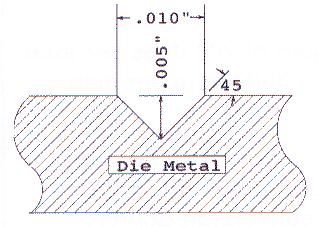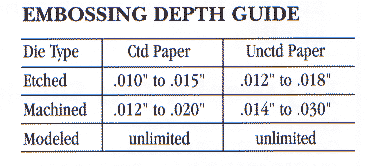Article Index
EmbossingBy: Ralph Pope
Reprinted from New England Printer & Publisher
Issue: November 1998
The designer wants his emboss so high you could drink coffee out of the back of it. The
pressman wants a nice shallow lift where he can smooth out the paper without fighting
crimped corners and cracked coatings all day. There is a balance here somewhere, but
sometimes it's hard to find. In a perfect world, the height of the emboss is dictated by
the depth of the embossing die, so this article will focus largely on the embossing die
design and depth. What I'll try to do here is outline the factors that need to be
considered in determining the optimum die depth for a particular design/stock combination,
and see if we can come up with some reasonable guidelines.
WHAT'S TOO DEEP?
Very simply, a die that's too deep is a die that doesn't deliver acceptable results on
press. The die attempts to deform the paper more than the paper can stand. Unfortunately,
this usually becomes totally clear only after the pressman has spent the better part of a
shift trying to get acceptable results.
Symptoms of a die that's too deep are most often crimping at the corners or cracking
and cutting through in highly detailed areas. Occasionally, you might notice a lack of
detail that results from reducing pressure to prevent cracking and crimping. Just to keep
things interesting the symptoms of an overly deep die can also be produced by a die with
walls that are too steep, or by a bad makeready.
WHAT'S NOT DEEP ENOUGH?
Pretty much anything that your customer doesn't like. A die that doesn't have enough
depth produces a weak looking lift that doesn't have enough contrast between high and low
areas. If the distinction between the high and low areas isn't adequate, there won't be
much shadow at the boundary area, and the result is a wimpy looking emboss.
Coated stocks don't need as much height contrast to look good because of the greater
reflectivity of the surface. This is fortunate because the brittleness of the coating
doesn't permit as much embossing depth as is possible with uncoated stocks.
SO HOW DEEP DO YOU GO?
Congratulations, you've just discovered the $64,000 question. In the next section we'll
explore a series of factors that affect not only how high we can emboss and how deep a die
we can make but also how effective an end result we can get.
MAJOR FACTORS:
Caliper
Lightweight stocks (under .010") just don't have adequate paper fiber to cushion and
strengthen the sheet surface during the stretching that a sheet undergoes in the embossing
process, so die depths have to be kept relatively shallow. Heavier stocks (12 to 14pt
range) offer much more cushioning and smoothing and they can be embossed as much as 50%
higher than lighter stocks.
Type of Stock
In general, coated stocks won't move as far as uncoated stocks because of the brittleness
of the coatings. For instance, if you raise the level of a coated sheet of paper by
.020" over a very short distance you will probably get some cracking. The brittle
coating can't stretch very much ' Uncoated stocks are a great deal less brittle, so they
are generally less prone to cracking, and your die can (and should) have more depth.
Fortunately, the coated sheets don't need a deep emboss to show good results because
the surface is so reflective. Even slight differences in surface level and angle show up
nicely.
Line Width
When making a die to emboss fine lines, the maximum possible die depth is often limited by
the width of the detail parts of the image. Very fine lines can't be embossed at the same
height as bold designs, and the reason is quite basic. The sides of an embossing die must
have some bevel or the paper will be sheared in the embossing process.
In making a die with fine lines, the bevels on the two sides of the embossed line meet
before they get down very far.
Lets assume for a minute that the edge of our die goes down (up for the paper) at a 45
degree angle. This angle means that for every .001" we etch downward, the etched wall
moves horizontally .001". As you can see on the following sketch, this yields a
maximum die depth of .005" for a line .010" wide.
With designs containing fine detail, the major factors controlling maximum die depth
are line width and slope. Obviously in this example anything thinner than .010" would
have to be shallower than .005".

Guidelines are different for the different types of dies, so we'll discuss them
separately:
ETCHED DIES
The sides of etched dies tend to be pretty vertical. The die maker can attempt to vary
the bevel during the acid etching process, but this is a cumbersome, inaccurate process at
best. The fact that the sides are fairly vertical means that the paper surface is brought
up to maximum height over a relatively short horizontal distance. This quick lift tends to
shear the paper, so heights are more limited than they would be in dies with a more
gradual lift, i. e. less vertical sidewalls.
MACHINED DIES
One way to get a predictable and less steep bevel is to machine the edge with a milling
machine. In this case the machine tool doing the beveling determines the shape of the
sidewall. You can decide to bevel 30 to 60 degrees, and the more gradual the bevel, the
higher you can go without tearing and/or deforming the paper.
The drawback of this type of die is cost. In order to make a bevel edged die, the
diemaker generally starts by making an etched die, and uses that die as a pattern to
machine the final die using a combination pantograph/milling machine. The cost of the
bevel edged die therefor starts with the cost of an etched die, and is increased by the
time and materials involved in transferring the shape to the final block of metal.
HAND ENGRAVED DIES
Hand engraved dies can also provide more height than etched dies, because the lift
takes place over a significant horizontal distance. Many hand modeled dies have depths
exceeding 1/16", but the lifting of the paper takes place over such a large distance
that the stress on the paper surface isn't high at all. Because of this, depths on hand
modeled dies aren't as critical as with etched and machined dies.
EMBOSSING DEPTH GUIDE
Lighter stocks are at the low end of the range and heavier stocks are at her higher end
of the range.

Article Index